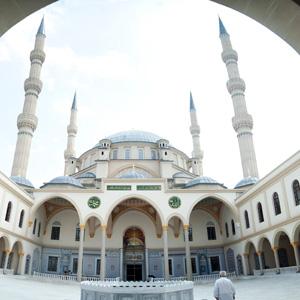God in the details
LISA VAN WYK

“Breathtaking” is a word that is overused, but if you have been fortunate enough to visit one of Ottoman architect Sinan’s masterpieces, such as the Süleymaniye Mosque in Istanbul, you will know exactly what that word can mean.
Everything about the building, from the dizzying scale of its elaborately decorated central dome, to details such as the hand-painted Iznik tiles which seem to adorn every available surface, takes one’s breath away. Upon entering the mosque for the first time, I gasped.
The Süleymaniye Mosque was built more than 500 years ago, and it is rare to find modern buildings that demonstrate the same meticulous and time-consuming craftsmanship. South Africans will soon be able to experience first-hand the attention to detail and proportion that is so characteristic of Ottoman design.
The Nizamiye Mosque complex in Midrand, which will be completed in early 2012, is based on the Selimiye Mosque in Edirne, Turkey, a building that was designed by Sinan in 1568. Like the original, the complex includes community facilities — a school for 800 pupils, a conference room, shops, a restaurant and a clinic.
No expense has been spared in the building’s design and execution, with total costs estimated at about R210-million.
Mandela’s blessing
The man behind the project is Turkish businessman Ali Katircioglu, who has relocated to South Africa with his wife for the duration of the project, and will return to his home in Istanbul when the building is complete.
Uncle Ali, as he is affectionately known, was encouraged to build the mosque and the school by his close friend Fethullah Gülen, an influential and often controversial Turkish cleric and philanthropist who now lives in the United States.
Katircioglu said the project was given Nelson Mandela’s blessing when he met the former president in 2007, who encouraged him to include facilities that would benefit the larger community, such as a clinic.
While these facilities are far from complete, the mosque itself is in the finishing stages, with a few skilled artisans (imported from Turkey) putting the final touches to its decorative elements.
The basic building blocks of the project, such as the 800 tonnes of concrete that was used to build the main structure of the mosque, have all been sourced locally and put together using a local workforce. The details, such as the tiles, the calligraphy, the painting on the dome and the stained glass windows, have all either been shipped to South Africa from Turkey, or have been completed locally using imported materials.
Imposing scale
The mosque’s distinctive silhouette is a welcome sight in the otherwise bland and uniform Midrand landscape that surrounds it, but it is only once one enters the complex that its scale becomes apparent. The mosque can accommodate 3 500 people, and many more if one includes its courtyard and the balconies on either side. Its central dome is 24 metres across and 32 metres high, only slightly smaller than Sinan’s imposing original, and the courtyard is bordered by 22 smaller domes.
Despite its size, no shortcuts have been taken when it comes to small details. The Iznik-style tiles have been used throughout the mosque’s interior and exterior, some embossed, some hand-painted. The heavy, carved doors have been imported from Turkey, and lead visitors into a room that, even in its unfinished state, is almost too much for the eye to take in at once. In January, the carpet was still to arrive but Mehmet Naci Kaya, who will be the headmaster of the school and who showed the Mail & Guardian around the complex, explained that it will mirror the hand-painted decorations that adorn the dome and ceiling.
The tour guide and Uncle Ali insisted that visitors would be welcome to explore the complex, and they hoped it would become a tourist attraction and meeting place for those of many faiths and backgrounds. Mosques, after all, have always been more than places of worship.
Hidden between the domes are solar panels that provide enough electricity to power the mosque’s lights and heat the water in the ablution rooms.
Full of life
While the juxtaposition between new technology and old design is probably worth noting, it was more interesting to learn about the mosque’s resident pigeons, who have been encouraged to make their homes in niches around the domes to ensure that the mosque is never devoid of life, even in the middle of the night.
But what is most striking about the building, and, I suppose, should really be the most notable part of any architecture, is how welcoming it is.
There is no doubt that Uncle Ali’s charm had something to do with this (he insisted on filling our pockets with sweets as we left), as did the patience with which my terrible attempts at basic Turkish conversation were tolerated.
But there is something the sanctuary of its courtyard, the generosity of its proportions, and the affection with which every detail has been produced, that leaves a visitor reluctant to leave, even if one only had the pigeons for company. Driving back to Jo’burg through endless stretches of anonymous, mass-produced and meanly-built complexes and construction projects only made this all the more obvious.
via God in the details – Leisure – Mail & Guardian Online.

Leave a Reply